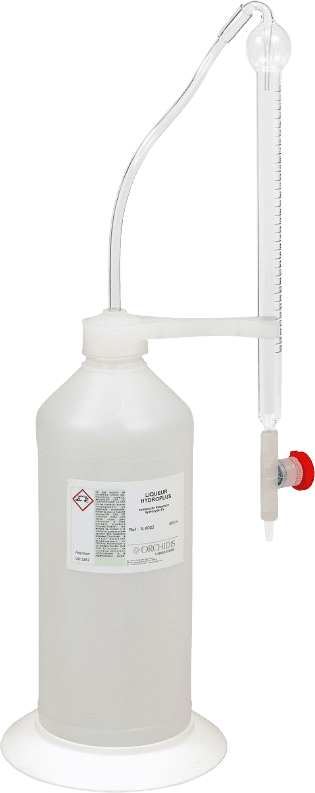
TA (AT Alkalimetric title) and TAC (CAT Complete Alkalinity Title) burette methods
Description
Assess the alkalinity concentration by gradually adding the alkalinity liquor to the sample. Watch the color change from pink to colorless with the TA indicator (CMR-free) or TA phenolphthalein (CMR). For the TAC helianthine the color change is from yellow to orange and from blue-green to pale pink with the TAC reagent.
Burette titration methods offer a greater titrant solution storage capacity, thereby increasing the number of tests and speed with which they can be performed.
Optional: burette with a stand or burette with bottle pressure fill.
Burette methods require a surface on which to place the burette. If you don’t have one, drop-counter methods are preferable.
Advantages
• Large scale reagents
• Burette with bottle pressure fill
• Suitable for frequent testing in an industrial environment.
• Option to add your logo
Assets
• CMR-free options available
• Highly accurate
• Fast
• Affordable
Similar products
Why trust AQUALABO?
AQUALABO, a French company, offers a combination of experience, innovation, international presence, adaptability, and ecological commitment, making it a trusted partner for water quality control.
FAQ TA (AT Alkalimetric title) and TAC (CAT Complete Alkalinity Title) burette methods
What is the difference between TA Alkalinity (AT Alkalimetric title) and TAC Total Alkalinity (CAT Complete Alkalinity Title)?
Alkalinity TA (AT Alkalimetric title) or p-alkalinity is the alkalinity of water at a pH of 8.3, indicating the alkalinity relative to hydroxides and half the alkalinity relative to carbonates.
Total alkalinity TAC (CAT Complete Alkalinity Title), also known as m-alkalinity (methyl orange alkalinity) or acid demand for KS4.3, is used to determine the content of reactive basic compounds (hydroxides, carbonates, bicarbonates, etc.) up to a pH of about 4.3, thus including weak acids. In the case of natural water, it mainly represents the bicarbonate HCO₃⁻. In some highly polluted waters (wastewater), the CAT may also include weak organic acids (acetic, etc.). This may also occur in some very colorful natural waters (humic matter).
Why test for alkalinity?
Alkalinity plays a fundamental role in maintaining pH stability. It is a critical parameter in assessing surface water quality and analyzing the corrosive behavior of water in general water treatment and wastewater treatment. Extreme levels alter the taste of water and cause mineral buildup in industrial plant.
What processes require alkalinity monitoring?
Power plants: Optimizing heat transfer and reducing costs are essential in power plants. Maintaining the alkalinity of the cooling system preserves the protective oxide layer on the metal pipes. However, excessive alkalinity can lead to unwanted deposits.
Swimming pools: If the alkalinity of the water is too low, the pH can get out of control. If it is too high, there is a risk of scale deposits or cloudy pool water. The CAT of your water should be between 80 and 120 mg/l.
Anaerobic digestion: Alkalinity is essential to maintain optimal pH and ensure that the biological process is working properly.
Ammoniacal nitrogen removal: Constant monitoring of alkalinity is essential to ensure stable nitrification.
Drinking water treatment: Alkalinity acts as a pH buffer, promoting effective coagulation and softening, while controlling corrosivity in the distribution system.
Drinks manufacturing: Alkalinity monitoring is essential to ensure the quality of drinks, preventing spoilage due to incorrect alkalinity.

